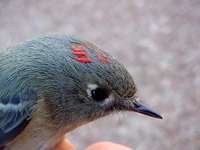|
|
|||
|
THIS WEEK at HILTON POND |
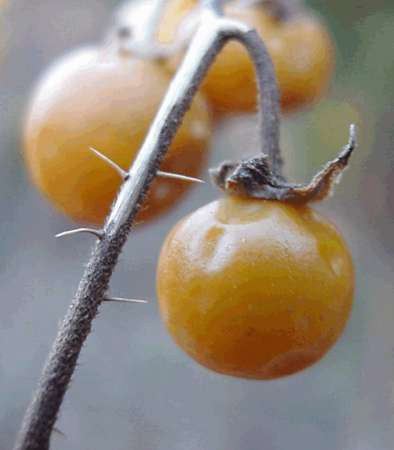 One of the great pleasures of summer is walking into the backyard garden and plucking a big, red, juicy tomato from the vine--assuming, of course, you've trained the neighborhood raccoons and birds not to beat you to the punch. Wouldn't it be great if we could pick Piedmont tomatoes in winter, too? Day-dreaming about such things on a January stroll at Hilton Pond Center, we chanced upon what looked for all the world like a tiny tomato growing along the trail. I could imagine a small child thinking the same thing and taking a bite out of this fruit, and I shuddered about what might happen. Although this trailside plant was in the same family as the tomato--the Solanaceae--its fruit isn't the sort of thing that humans should be putting in their mouths, especially because that plant family is better known as the "Nightshades." Nightshades are a worldwide family that contains many plants with highly toxic fruits; in fact, the Tomato (Lycopersicon esculentum) is one of the few nightshades that is edible. Locally, a common nightshade is Carolina Horse-nettle (Solanum carolinense), the plant with yellow fruits that we saw at Hilton Pond Center. As the name suggests, Carolina Horse-nettle is native to the southern Piedmont; shipments of hay and other agricultural products have helped extend horse-nettle's range into farmland of the northeastern and northcentral U.S., where it has caused poisoning in livestock. Carolina Horse-nettle stands one to four feet tall and has irregular branches usually covered with fine hairs. The branches--as well as the leaf petioles and midveins--are armed with yellowish quarter-inch prickles (see top photo). Such spines, which are also characteristic of the true nettles (Urticaceae), give Horse-nettle its name; the "horse" part indicates the plant often grows in pastures. As in all noxious nightshades, the fruits of Carolina Horse-nettle contain solanine glycoalkaloids that cause severe gastrointestinal distress in humans. There also may be toxic levels of nitrates, and the green plant can cause dermatitis, especially if one's skin is scratched by its spines; this alone should be enough information to keep a knowledgeable person from eating or touching the plant.
And here's one last piece of botanical trivia about Carolina Horse-nettle that may surprise you: classified with it in the Nightshade Family are such familiar plants as Jimson-weed, Tobacco, Peppers, and those most menacing and frightful of ornamental flowers . . . . Petunias! If you enjoy "This Week at Hilton Pond," please help Support Hilton Pond Center for Piedmont Natural History |

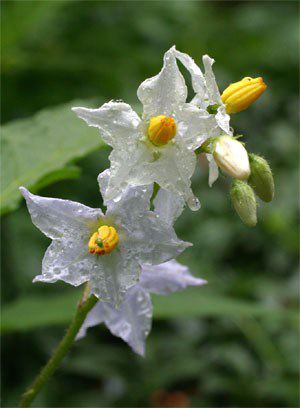 The fruit had the right shape, it hung off the plant in the right way, and the old flower parts at the base of the stem curled up in characteristic tomato fashion. True, it WAS yellow-orange and only a half-inch in diameter, but otherwise it certainly looked like a tomato.
The fruit had the right shape, it hung off the plant in the right way, and the old flower parts at the base of the stem curled up in characteristic tomato fashion. True, it WAS yellow-orange and only a half-inch in diameter, but otherwise it certainly looked like a tomato.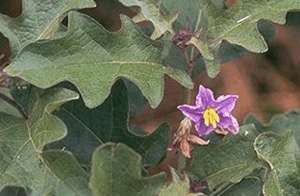 In spring and summer, its large-lobed leaves and one-inch purple or white flowers with yellow stamens can be seen in weedy areas and disturbed meadows, but it is most easily found when its drooping clusters of golden berries sparkle in the winter sun.
In spring and summer, its large-lobed leaves and one-inch purple or white flowers with yellow stamens can be seen in weedy areas and disturbed meadows, but it is most easily found when its drooping clusters of golden berries sparkle in the winter sun.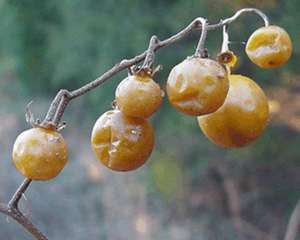 As might be expected of a highly toxic plant, dilute concentrations of Carolina Horse-nettle have been used for medicinal purposes as a treatment for epilepsy, kidney problems, internal worms, poison ivy rash, and dog mange, and--perhaps surprisingly--as an aphrodisiac. ('Twould seem difficult to be very amorous whilst one's guts were being wrenched by solanine glycoalkaloids.)
As might be expected of a highly toxic plant, dilute concentrations of Carolina Horse-nettle have been used for medicinal purposes as a treatment for epilepsy, kidney problems, internal worms, poison ivy rash, and dog mange, and--perhaps surprisingly--as an aphrodisiac. ('Twould seem difficult to be very amorous whilst one's guts were being wrenched by solanine glycoalkaloids.)